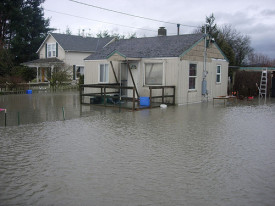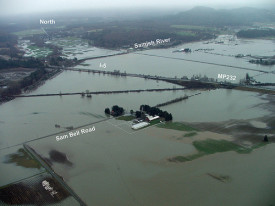
See mud on tree, build higher.
This was the advice that Native Americans reportedly offered the pioneers that settled along flood-prone stretches of the Skagit River. The immigrants were of hearty stock, but they weren’t good listeners.
“They decided to ignore the Indians,” said Noel Bourasaw, editor of the Skagit River Journal.
In the late 1890s, two riverside settlements essentially floated away in the Skagit’s flood waters. But the neighboring town of Hamilton held on.
Fast forward 120 years.
Despite being repeatedly inundated by the Skagit, Hamilton’s inhabitants have kept their tenuous grip thanks in large part to the National Flood Insurance Program, which has helped residents rebuild time after time. It’s the same FEMA program that is expected this week to run out of money to pay flood insurance claims, never mind the billions of additional dollars that are needed to aid the victims of Hurricane Sandy. Did I mention that over the years the program has borrowed $18 billion from taxpayers to settle claims nationwide?
And here’s one more reason not to love FEMA’s insurance program: federal scientists, the courts, and environmentalists agree that it harms endangered species including Northwest salmon and orcas.
Foundering in flood claims
The Federal Emergency Management Agency’s insurance program was established 1968 in an attempt to make those living in flood-prone areas pay for damage to their homes and belongings through insurance premiums, rather than burdening taxpayers. The program enables builders to construct houses, businesses, and roads in areas at risk of flooding by offering insurance that would not otherwise be available through the private sector. The policy encourages municipalities to build levees and dikes and mound fill into floodplains, altering sensitive ecosystems, to protect developments.
While many floodplains are not well suited to human inhabitants, they can provide great habitat for fish and other species. As I explain in a recent story published in High Country News that I wrote for Investigate West, an independent journalism organization:
Floodplains are a sanctuary for salmon in high water. The water flows shallowly across the land, providing a calm haven with easy swimming and fewer predators. Young finger-sized fish thrive, gorging on bugs among the flooded trees and shrubs. Because floodplains are so important to salmon, long-term plans to recover the fish emphasize curtailing new development and encourage restoration of damaged areas.

The huge costs incurred by Hurricane Sandy have renewed scrutiny on the National Flood Insurance Program. Recent articles in Grist chastise the government for failing to keep the program current, which means insurance policy holders have been paying premiums that are much too low. An opinion piece in the New York Times calls for scrapping the program all together, noting that taxpayers are backing assets worth $527 billion. Keep in mind that these properties are at ever greater risk as climate change increases the likelihood of flooding from the Northwest to the Florida panhandle.
Enviros call for change
For nearly 20 years environmentalists have been calling for an overhaul of FEMA’s flood insurance program in the name of threatened and endangered deer, sea turtles, jaguar, and other wildlife.
- In 1994, the National Wildlife Federation and others sued FEMA in Florida, claiming that the insurance program encouraged floodplain construction that was harmful to Key deer and other wildlife protected under the Endangered Species Act.
- In 2003, NWF sued the government in Washington, arguing that the same program was threatening Northwest species.
- In 2009, NWF, Audubon Society of Portland, Northwest Environmental Defense Center, and the Association of Northwest Steelheaders filed suit against FEMA in Oregon on behalf of salmon and steelhead.
The environmentalists have prevailed in all of these cases—and numerous similar challenges in the West.
But the fight continues because while Hamilton represents the legacy of poor construction decisions, building and rebuilding continues in flood-prone areas.
In 2011 alone, Puget Sound cities and counties approved more than 600 projects in floodplains. Environmentalists want FEMA and municipalities to curb this construction to protect species and taxpayers. They’re employing the courts and the Endangered Species Act to force them to take action.

“Salmon could end up improving public safety by preventing people from building in dangerous places,” said Dan Siemann, senior environmental policy specialist with the NWF. Changing the program could “protect people, save salmon, save money. It’s a win win win for everybody.
“This is where the environmentalists and the Tea Party come together,” Siemann quipped in an interview with me.
In Washington, NWF is in the midst of another court challenge against FEMA. After their successful suit in 2003, the group sued again in 2011 claiming the agency still hadn’t changed its ways.
Turning the battleship
FEMA officials counter that they’re making progress. This summer, the agency accepted public comment on a plan to prepare an environmental impact statement for the flood insurance program, which could include updates to better protect wildlife.
John Graves, senior National Flood Insurance Program specialist for the Northwest, says change is happening.
“We’re changing the culture of floodplain management. It used to be about armoring and keeping the water away. Now we’re moving into a new culture of protecting natural, beneficial functions as well as protecting people and property. The battleship is turning.”
But here’s the kicker. Even if new construction were to be greatly limited in floodplains, or done in a way that’s more sensitive to the environment while remaining structurally sound, there remains the decades worth of existing development that stands in the path of flood waters.
Here’s the advice of the New York Times commentary for fixing the situation:
We do not underestimate the complexity and political difficulty of phasing out a popular program like national flood insurance, nor do we think the government should abandon people who are currently insured. But Congress and the president should challenge the status quo and make some tough decisions, like providing subsidies or buyouts to encourage people to move out of the most disaster-prone areas, and eliminating other government incentives that support living in high-risk areas…
But with careful planning and a gradual shift away from the coast, Americans can still enjoy the beauty and live safely, yet escape the cycle of catastrophe and response, in which so much money is expended on properties that are repeatedly flooded.
And I’ll add that the salmon, orcas, and other species sliding toward oblivion would be much obliged if floodplains were allowed to return to a more natural state.
Editor’s note: This post was updated Jan. 8, 2013 regarding where the Indians gave their warning to settlers. According to Larry Kunzler, keeper of the Skagit River History webpage, the location was a community downriver from Hamilton.


Comments are closed.